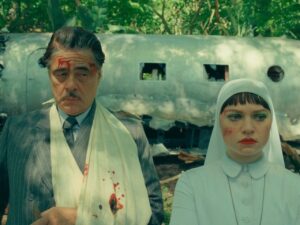[imagesource: Brent Stirton]
In September, we showed you some of the highly commended winners for 2021’s Wildlife Photographer of the Year competition.
Those images were already incredibly wild, gripping, deep, and great. Check them out and you will know where those adjectives come from.
Well, from more than 50 000 entries across 95 countries, the winners have been announced.
Geographical has those covered, displayed alongside insights from Natural History Museum scientists and experts.
Atop is one of the winners, Brent Stirton’s image of Virunga National Park pilot Anthony flying two orphan chimpanzees to the safety of a rehabilitation centre:
The babies were rescued from traffickers following a tip-off from locals. Baby chimps have little meat value, but are often sold as pets or for animal shows.
At this stage they are unlikely to survive without specialist care, needing formula milk and regular balanced meals.
Stirton’s work, which has been featured in National Geographic magazine, has evolved into investigative essays on endangered species and habitats, with an emphasis on the illegal wildlife trade.
The overall winner was French underwater photographer and biologist Laurent Ballesta, with this image:

It is an evocative depiction of camouflaged grouper fish as they burst from a nebulous cloud of their eggs and sperm in Fakarava, French Polynesia:
For five years, Ballesta’s team annually returned to the lagoon. Day or night, they would dive to see the annual spawning of camouflage groupers. Spawning occurs around July’s full moon, when up to 20 000 fish gather in a narrow southern channel linking the lagoon with the ocean.
In the surrounding waters, overfishing threatens the species, but in Fakarava, they are protected within a ‘biosphere reserve’ – UNESCO-designated areas to test interdisciplinary approaches to managing changes and interactions between social and ecological systems.
Another winning photographer is Adam Oswell from Australia for his captivating shot of the ‘Elephant in the room’, drawing attention to zoo visitors watching a young elephant perform underwater:

Although this performance was promoted as educational and as exercise for the elephants, Adam was disturbed by this scene. Organisations concerned with the welfare of captive elephants view performances like these as exploitative because they encourage unnatural behaviour.
USA’s Jennifer Hayes draws attention to the drama of the natural world with this image titled ‘Nursery meltdown’ of harp seals, seal pups, and the blood of birth against melting sea ice:

Following a storm, it took hours of searching by helicopter to find this fractured sea ice used as a birthing platform by harp seals. ‘It was a pulse of life that took your breath away,’ says Jennifer.
Every autumn, harp seals migrate south from the Arctic to their breeding grounds, delaying births until the sea ice forms. Seals depend on the ice, which means that future population numbers are likely to be affected by climate change.
Then, there’s Martin Gregus who got the Rising Star Portfolio Award for this image of two bears, an adult and a cub, taking an afternoon nap, titled ‘Summer siesta’:

He was hesitant to use the low-noise drone but neither stirred.
Young bears remain dependent on their mothers for two to three years to learn all the skills they need. Wolves in this area of Manitoba have learnt to attack young bears and this may be how the cub lost its leg.
Shane Kalyn’s photograph of ‘The Intimate Touch’ between two ravens also nabbed a prize:

It was midwinter, the start of the ravens’ breeding season. Shane lay on the frozen ground using the muted light to capture the detail of the ravens’ iridescent plumage against the contrasting snow to reveal this intimate moment when their thick black bills came together.
Ravens probably mate for life. This couple exchanged gifts – moss, twigs and small stones – and preened and serenaded each other with soft warbling sounds to strengthen their relationship or ‘pair bond’.
That makes them awesome, don’t you think?
‘Head to head’ by Italy’s Stefano Unterthiner was the winner for the Behaviour: Mammals category for this shot of two Svalbard reindeer battling it out over a harem:

Stefano followed these reindeer during the rutting season. Watching the fight, he felt immersed in ‘the smell, the noise, the fatigue and the pain’. The reindeer clashed antlers until the dominant male (left) chased its rival away, securing the opportunity to breed.
‘Grizzly leftovers’ by Zack Clothier won for the category Animals in their Environment, which got attention thanks to the grizzly bear taking a keen interest in his camera trap:

Zack decided these bull elk remains were an ideal spot to set a camera trap. Returning to the scene was challenging. Zack bridged gushing meltwater with fallen trees, only to find his setup trashed. This was the last frame captured on the camera.
Grizzlies, a subspecies of brown bears, spend up to seven months in torpor – a light form of hibernation. Emerging in spring, they are hungry and consume a wide variety of food, including mammals.
For more wildlife photography escapism, head here, where polar bears and chimpanzees reign supreme.
[source:geographical]





